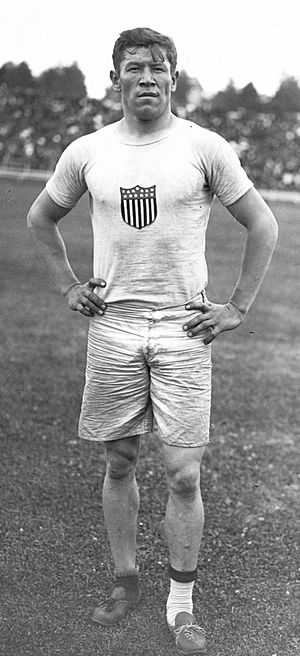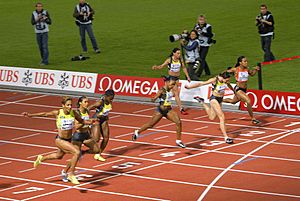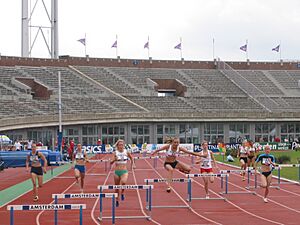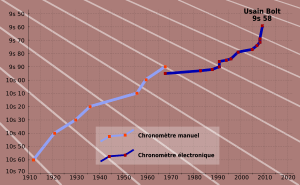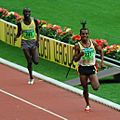Track and field facts for kids
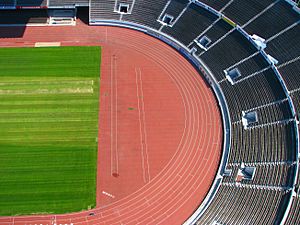
Part of a track and field stadium
|
|
| Characteristics | |
|---|---|
| Team members | Yes |
| Mixed-sex | Yes |
| Type | Sport |
| Presence | |
| Olympic | Yes |
Track and field is an exciting sport where athletes show off their skills in running, jumping, and throwing. The name comes from the places where these events happen: a special running track and a grassy field. Track and field is part of a bigger group of sports called sport of athletics, which also includes road running, cross country running and racewalking.
In running events, like sprints, middle-distance, and long-distance races, the winner is the athlete who finishes fastest. For jumping and throwing events, the winner is the one who achieves the greatest distance or height. Common jumping events are long jump, triple jump, high jump, and pole vault. Popular throwing events include shot put, javelin, discus, and hammer.
Some athletes compete in "combined events," like the heptathlon (seven events) or decathlon (ten events). Here, athletes do a mix of running, jumping, and throwing events. Most track and field events are for individuals, but relay races are team events, usually with four athletes. Events are mostly separated by gender, but "mixed" relay events with two men and two women are becoming popular. If too many people sign up for a race, they run smaller "heats" first to pick the fastest athletes.
Track and field is one of the oldest sports. It was part of the Ancient Olympic Games in Greece. Today, the biggest international competitions are the Olympic Games and the World Athletics Championships. World Athletics is the main group that sets the rules for the sport around the world.
Records are kept for the best performances in each event, from national to world levels. If an athlete breaks the rules, their performance is not counted.
History of Track and Field
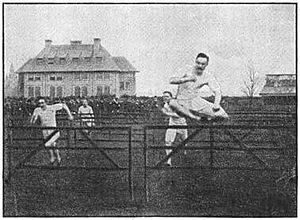
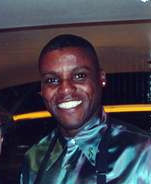
Track and field has a very long history. Running, jumping, and throwing are natural human actions, so these sports have been around for ages. The first organized events were part of the Ancient Olympic Games in Greece. These games included running races and the Ancient Olympic pentathlon, which had five events: long jump, javelin throw, discus throw, a footrace, and wrestling.
Track and field events also happened at the Panhellenic Games in Greece and later spread to Rome. In the Middle Ages, new events appeared in Northern Europe. For example, the stone put and weight throw in Ireland and Scotland were early versions of the modern shot put and hammer throw. The pole vault developed later, from competitions like fierljeppen in the 1700s.
Separate track and field competitions started in the 1800s. These were often organized by schools, military groups, and sports clubs. The Royal Shrewsbury School Hunt in England, started in 1819, is the oldest running club. They held "Paper Chase" races where runners followed paper shreds. The school also had the oldest track and field meeting, first recorded in 1840.
In 1851, the first Wenlock Olympian Games were held in England. They included a "half-mile foot race" and a "leaping in distance" contest. Later, in 1865, Dr. William Penny Brookes helped create the National Olympian Association. This group held successful games in London in 1866, drawing over ten thousand people. The Amateur Athletic Association was formed in 1880, becoming the first national group for athletics in Britain.
In the United States, the New York Athletic Club began holding national competitions in 1876. The creation of groups like the Amateur Athletic Union in the U.S. and similar groups in France made international competitions possible.
The return of the Olympic Games in 1896 brought new attention to track and field. The Olympic athletics program, which included track and field events and a marathon, became very important. The Olympics also helped make metric measurements standard for distances in track and field. The program grew over the years, and track and field remained a key part of the Games.
Early Olympics only allowed amateur athletes. For example, Jim Thorpe lost his medals from the 1912 Olympics because he had received money for playing baseball, which broke the amateur rules. His medals were given back to his family much later.
In 1912, the International Amateur Athletic Federation (IAAF) was created to govern track and field worldwide. It also supported the idea of amateurism. College competitions, like the NCAA Men's Outdoor Track and Field Championship, started in 1921. The first continental championship was in South America in 1919, followed by Europe in 1934.
Until the 1920s, track and field was mostly for men. Women's participation was rare. Alice Milliat fought for women to be included in the Olympics. She founded the International Women's Sports Federation in 1921. This led to the Women's World Games, held several times between 1922 and 1934. These efforts helped bring five track and field events for women to the athletics at the 1928 Summer Olympics. More women's events were added over time, and by the end of the century, men's and women's programs were almost equal. Competitions for disabled athletes also began at the 1960 Summer Paralympics.
From the 1960s, track and field became more popular with television coverage. In the late 1970s, the sport moved from amateur to professional. The IAAF changed its rules in 1982 to allow professional athletes. In 1983, the IAAF World Championships in Athletics began, becoming another major competition alongside the Olympics.
The sport was very popular in the 1980s, with stars like Carl Lewis and Florence Griffith Joyner. Many world records were broken. New training methods and equipment also improved. However, the use of performance-enhancing drugs also increased, which hurt the sport's image.
Since the 1990s, track and field has become even more professional and global. The IAAF World Championships started offering prize money in 1997. The IAAF Golden League and later the Diamond League offered big cash prizes, making the sport more appealing worldwide.
Types of Events
Track and field events are split into three main types: track events, field events, and combined events. Most athletes choose to focus on one type to become really good at it. Combined events athletes, however, aim to be good at many different skills.
Track events involve running on a track over specific distances. Some, like hurdling and steeplechase, include obstacles. Relay races are team events where runners pass a baton to their teammates.
Field events are either jumps or throws. In jumping, athletes are judged on how far or how high they jump. For distance jumps, athletes jump from a board, and if they step over it, it's a foul. For height jumps, athletes must clear a bar without knocking it down. In the pole vault, athletes use a special pole to help them jump higher.
Throwing events involve throwing an object like a heavyweight, javelin, or discus from a set spot. Athletes are judged on how far they throw the object.
Combined events involve the same athletes competing in several different track and field events. Points are given for each performance, and the athlete with the most points wins.
Track Events
Sprints
Sprints are short-distance races and are some of the oldest running competitions. The first Olympic Games only had one event: a sprint across the stadium. Sprinters focus on reaching and keeping their fastest possible speed. The main Olympic sprint events are the 100, 200, and 400 metres. These distances came from older races measured in yards.
Professional sprinters start in starting blocks, crouching low, then gradually stand up as they gain speed. Athletes stay in their own lane for most sprints. Races up to 100 m are all about quick acceleration. Longer sprints also need endurance, as runners can only keep their top speed for about 20 meters.
The 60 metres is a common indoor sprint. Other less common sprints include the 50, 55, 300, and 500 meters. The 150 metres is rarely run but has seen famous athletes like Usain Bolt set records.
Middle Distance Running
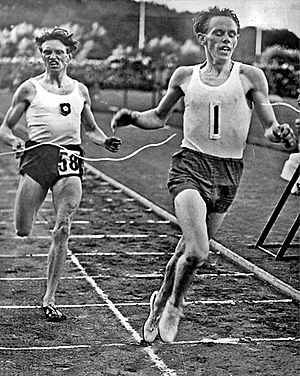
The most common middle-distance races are the 800 metres, 1500 metres, and mile run. The 3000 metres can also be considered middle-distance. The 800 m race came from the 880-yard run (half mile) in the 1830s. The 1500 m race became popular because it was three laps on a 500 m track.
Middle-distance races can start in two ways. In the 800 m, athletes start in staggered lanes and must stay in their lane for the first 100 m. This helps prevent bumping. For 1500 m and longer races, runners start in a group along a curved line and then quickly move to the inside lane. These races require athletes to have good aerobic and anaerobic fitness, plus strong endurance.
The 1500 m and mile run have always been very important events. Runners like Roger Bannister, who first ran the four-minute mile in 1954, made these races famous. In the 1990s, athletes from North Africa, like Hicham El Guerrouj, became dominant in these events. For middle-distance races, qualities like pace, strategy, and endurance are more important than quick reactions or top speed.
Long Distance Running

Three common long-distance running events in track and field are the 3000, 5000, and 10,000 metres. The 5000 m and 10,000 m are Olympic events. The 3000 m is usually run indoors. These races came from older 3-mile and 6-mile races. The 3000 m used to be a women's long-distance event in the Olympics, but it was replaced by the 5000 m in 1995. Marathons are also long-distance races, but they are usually run on streets, not on a track.
Long-distance track races are similar to middle-distance races in rules and physical demands. However, pacing, stamina, and strategy become even more important. Some athletes have been successful in both middle and long-distance events. Elite races often use "pace-setters" to help runners achieve fast times, but these are not used in championship races where everyone wants to win.
Long-distance running became popular in the 1920s thanks to "Flying Finns" like Paavo Nurmi. In the 1950s, Emil Zátopek showed the importance of intense training. Since the 1990s, runners from Kenya and Ethiopia have been very strong in these events.
Relay Races
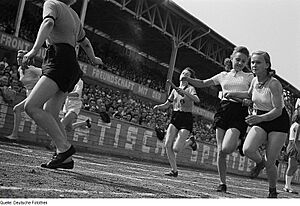
Relay races are the only track and field events where teams compete directly against each other. A team usually has four runners of the same gender. Each runner completes a certain distance (called a "leg") and then passes a baton to a teammate. There's a special area where the baton must be exchanged. Teams can be disqualified if they drop the baton or don't pass it in the right area. They can also be disqualified if they block other teams.
Relay races started in the United States in the 1880s. The most common relay events are the 4×100 metres relay and the 4×400 metres relay. Both became Olympic events in 1912. In the 4×100 m, teams stay in their own lane for the entire race. In the 4×400 m, runners stay in their lanes for the first part of the race, then can move to the inside lane. For later baton changes, teams line up based on their position in the race.
The IAAF keeps world records for five types of track relays: 4×100 m, 4×200 m, 4×400 m, 4×800 m, and 4×1500 m. Other relays, like the distance medley relay and Swedish medley relay, are also popular in some regions. Many large track and field events in the U.S. focus mainly on relay races.
Hurdling
Hurdle races, with obstacles, became popular in England in the 1800s. Early races used heavy wooden barriers. The rules for the men's 110 metres hurdles were set in 1864: a 120-yard race with ten hurdles, each 3 feet 6 inches (1.06 m) high. When the race became metric (110 m), the basics stayed the same. The 400 metres hurdles also started in England around 1860. Modern rules for this race were set at the 1900 Summer Olympics: 400 m with ten 3-foot (91.44 cm) hurdles. Women's hurdles are a bit lower.
The most common hurdle events are the 100 m hurdles for women, 110 m hurdles for men, and 400 m hurdles for both. The men's 110 m hurdles has been in every modern Summer Olympics. Women first competed in the 80 m hurdles in 1932, which changed to 100 m hurdles in 1972. The women's 400 m hurdles was added to the Olympics in 1984.
Besides hurdle races, the steeplechase is another track event with obstacles. It started in Oxford, England, as a human version of horse steeplechase. The 3000 metres steeplechase became the standard event at the 1920 Summer Olympics. It's run on a 400 m track and includes a water jump on each lap. While men's steeplechase has a long history, the women's event only became an Olympic sport in 2008.
Field Events
Jumping Events
Long Jump
The long jump is one of the oldest track and field events, dating back to the ancient Greek pentathlon. Ancient athletes would run a short distance and jump into dug-up earth. They even held small weights to help them jump farther. The modern long jump, standardized around 1860, is similar but without weights. Athletes sprint down a track, jump from a board, and land in a sandpit. The distance is measured from the board to the closest point where the athlete's body touches the sand.
The men's long jump was in the first Olympics in 1896, and a women's competition was added in 1948. Good long jumpers need strong acceleration and sprinting skills. They also need a consistent stride to jump close to the board while running at top speed. There's also a standing long jump, where athletes jump from a still position without a run-up. This was an Olympic event from 1900 to 1912.
Triple Jump
The triple jump is like the long jump, taking place on a track leading to a sandpit. Originally, athletes would hop twice on the same leg before jumping. But from 1900, it changed to the "hop, step, and jump" pattern. There's some debate if the triple jump was in ancient Greece. An Irish manuscript from the 12th century mentions "triple jump" contests.
The men's triple jump has been in every modern Olympics. The women's version became a World Championship event in 1993 and an Olympic event in 1996. The men's standing triple jump was in the Olympics in 1900 and 1904 but is now rare. The current world record for men's triple jump is 18.29 meters (60 ft 0in) by Jonathan Edwards. The women's world record is 15.67 meters (51 ft 4 3/4in) by Yulimar Rojas.
High Jump
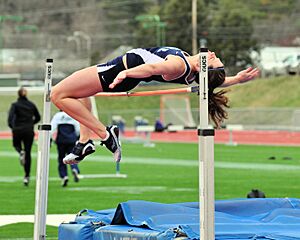
The first recorded high jump competitions were in Scotland in the 1800s. Rules for the modern event were set in 1865. Athletes have a short run-up, then jump off one foot over a horizontal bar, landing on a soft mat. The men's high jump was in the 1896 Olympics, and the women's competition started in 1928.
Jumping techniques have changed a lot. In the late 1800s, jumpers often went over feet first. The "straddle technique" was popular in the mid-1900s. But in the late 1960s, Dick Fosbury invented the "Fosbury Flop" – a backward, head-first technique – which won him gold at the 1968 Olympics. This technique is now used by almost all high jumpers. The standing high jump was an Olympic event from 1900 to 1912 but is now uncommon.
Pole Vault
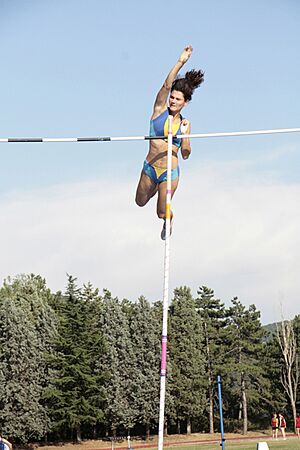
Using poles to vault over distances was seen in "Fierljeppen" contests in Europe. Vaulting for height was part of German gymnastics in the 1770s. One of the earliest recorded pole vault competitions was in England in 1843. The basic rules and technique came from the United States. Early poles were made of wood, metal, or bamboo, but modern poles are made from fiberglass or carbon fiber. Landing mats were added in the mid-1900s for safety as athletes jumped higher.
In the modern event, athletes run down a track, plant the pole in a metal box, and vault over a horizontal bar. They let go of the pole and land on a soft mat. The pole vault has been an Olympic event for men since 1896. However, the first women's world championship was in 1997, and the first women's Olympic pole vault was in 2000.
Throwing Events
Track and field includes some of the most important throwing sports. The four main throwing events are the only pure throwing events in the Olympic Games.
Shot Put

The shot put started from ancient competitions using rocks. In the Middle Ages, "stone put" was popular. In the 1600s, throwing cannonballs was a precursor to the modern sport. The name "shot" comes from these cannonballs. The first rules were set in 1860, requiring throws from a square area. In 1906, it changed to a circular area with a seven-foot diameter. The weight of the shot was set at 16 pounds (7.26 kg). Throwing techniques also improved.
The shot put has been an Olympic sport for men since 1896. A women's competition, using a 4 kg (8.82 lb) shot, was added in 1948. After World War II, new throwing techniques appeared. In the 1950s, Parry O'Brien made the "glide" technique popular, where athletes turn 180 degrees before throwing. Later, the "spin" or rotational technique was introduced in 1976.
Discus Throw

In the discus throw, athletes try to throw a heavy disc the farthest. They throw from a circular area. The discus throw is very old, dating back to 708 BC as part of the ancient pentathlon. In ancient times, a heavy circular disc was thrown from a standing position. This style was used in the 1896 Olympics. By the 1912 Olympics, the modern style of turning and throwing became standard. The discus was standardized to 2 kg (4.4 pounds) and 22 cm (8 inches) in diameter in 1907. The women's discus was one of the first women's Olympic events, added in 1928. The first modern athlete to throw the discus while rotating his whole body was František Janda-Suk in 1900.
Javelin Throw

The javelin throw began in prehistoric times as a way to hunt and for war. It was the second throwing event in the ancient Olympic pentathlon. Ancient competitions had two types: throwing at a target and throwing for distance. The modern event comes from throwing for distance. In ancient times, athletes used a leather strap to help throw farther. The javelin throw became very popular in Scandinavia in the late 1800s. In the modern event, throwers have a short run-up and release the javelin before a foul line. The runway is at least 30m long.
The first Olympic men's javelin throw was in 1908, and a women's competition was added in 1932. Early javelins were made of wood. In the 1950s, Bud Held introduced hollow and metal javelins, which helped throwers achieve greater distances. Later, Miklós Németh invented a javelin that could be thrown over 100 m. Because throws were getting too long for stadiums, the IAAF redesigned the men's javelin to reduce distance and make it land more easily. The new javelin specifications are 2.6 to 2.7 m long and 800 grams for men, and 2.2 to 2.3 m and 600 g for women.
Hammer Throw
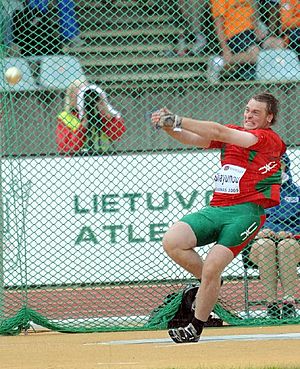
The earliest versions of the hammer throw come from ancient Ireland, where people threw weights attached to ropes, or even chariot wheels. Other old competitions involved throwing a cast iron ball with a wooden handle, which is where the name "hammer throw" comes from. In 16th century England, people threw actual blacksmith's sledgehammers. The hammer was standardized in 1887. The metal ball weighs 16 pounds (7.26 kg), and the wire attached to it is about 1.175 m to 1.215 m long.
The men's hammer throw became an Olympic event in 1900. The women's event, using a 4 kg (8.82 lb) weight, became an Olympic event much later, in 2000. Distances thrown by men increased from the 1950s due to better equipment, concrete throwing areas, and advanced training. While early hammer throwers were big and strong, modern throwers also need refined technique, speed, and flexibility. The throwing area has been reduced, and the technique now involves three to four controlled spins.
Combined Events
Combined events are competitions where athletes compete in several track and field events. They earn points for their performance in each event, and the athlete with the highest total score wins. Outdoors, the most common combined events are the men's decathlon (ten events) and the women's heptathlon (seven events). Indoors, there are fewer events, so men compete in a heptathlon and women in a women's pentathlon. Points are given based on a standard scoring system.
The Ancient Olympic pentathlon was an early form of combined events. A men's all-around competition was held at the 1904 Summer Olympics.
Records
Athletes' performances are timed or measured in almost all track and field competitions. This helps determine the winner and allows for comparing performances over time. There are many types of records, and men's and women's performances are recorded separately. Records are organized by region: national records, then continental records, and finally world records. National groups manage national records, continental groups manage their records, and the IAAF approves world records.
The IAAF first published a list of world records in 1914, only for men's events. Women's world records began in 1936. In the late 1970s, big changes were made. In 1976, all records measured in imperial units (like yards) were dropped, except for the mile run because it's so famous. The next year, all sprint world records had to be timed using fully automatic electronic timing instead of hand stopwatches. By 1981, electronic timing was required for all world record runs. In 1987, two new types of world records were added: indoor records and junior records for athletes under 20.
Other important records are those achieved at specific competitions, like the Olympic records for the Summer Olympics. All major championships and games have their own records. There are also stadium records, records by age, records by disability, and records by school or club. Athletes often get cash bonuses for breaking big records, which helps make track and field competitions more exciting for the public.
Related Sports
Track and field is very similar to other sports in the sport of athletics, such as cross country running, and road versions of racewalking and running. In these sports, finishing times are recorded, and they usually have clear start and finish points. Middle- and long-distance runners often compete in cross country and road events too.
Some strength athletics events, like the World's Strongest Man and highland games, include running, carrying heavy objects, and throwing events like the caber toss and keg toss. These are similar to track and field throwing events.
Images for kids
-
Arne Andersson (left) and Gunder Hägg (right) broke a number of middle distance world records in the 1940s.
-
Ethiopian runner Kenenisa Bekele leading in a long-distance track event.
-
Girls handing over the baton in a relay race in Leipzig in 1950.
-
A woman attempting to high jump while using the Fosbury Flop technique.
-
Anna Giordano Bruno releases the pole after clearing the bar in pole vault.
-
Remigius Machura preparing to throw within the circle in shot put.
-
Zoltán Kővágó preparing to spin and throw in discus throw.
-
A javelin throw athlete.
-
Yury Shayunou spinning with the hammer within the circle in hammer throw.
 In Spanish: Atletismo para niños
In Spanish: Atletismo para niños
- Cross country running
- List of track and field stadiums by capacity
- Racewalking
- Road running


